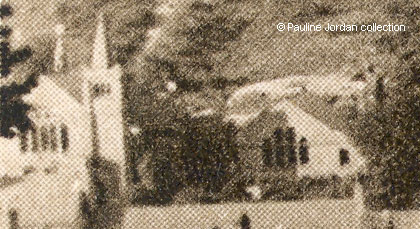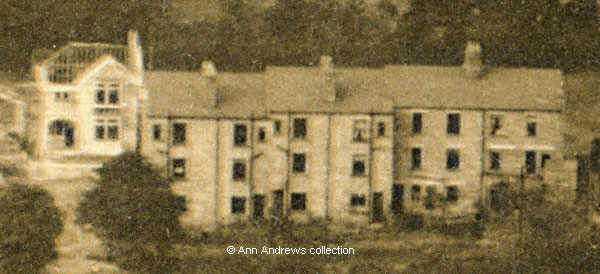|
Images Index> Matlock, 20th and 21st Century Images> This page |
| Matlock Bank, 1911 - 1914 |
| Matlock : Twentieth Century Photographs, Postcards, Engravings & Etchings |
|
|||||||||
The terrace of six houses on Edge Road in the centre of the above photograph was built against the hillside, so fronting the street the houses are two storeys whereas at the back they are three storeys - the view we can see here. Of the occupied houses, Edward Barratt, an insurance clerk, lived at Mayfield with his family and at Fernlea next door was George Challand Pearson with his wife and son. Mr. Pearson was a tailor. Two more new builds were on the other side of the road, opposite what is today Edgefold Road. In the top image we can see the shell of 14 Edge Road, which was without a roof. If we look closely at the second postcard below we discover a second property, similar in style though not identical, had been built next door and we know this is Edgemount or 16 Edge Road.
At a Matlock UDC meeting in 1911 Mr. Richards stated that a good deal of motor-bike racing was taking place on Bank Road on Sunday afternoons. The motor cyclists congregated in Crown Square and then rode their bikes up and down the hill for a couple of hours. The smoke and dust they created was considered a great nuisance. In addition, similar racing had happened on Steep Turnpike on three Sundays that summer. The Council decided to seek advice from Police Superintendent Clarke. At the same meeting the Council received a letter from the Matlock photographer Frederick Barber who lived on New Street complaining that the tram had recently carried him past his house, where he wanted to alight, as a wheelbarrow was blocking the way. The conductor was chastised and the Council promised that they did not think such an annoyance would happen again[3].
 Detail from the "General View", above. United Methodist Church and Sunday School, Imperial Road. See Churches & Chapels. From the Vernon Lamb Archive:
|
|||||||||
1." Bank Road, Matlock, Derbyshire". Published by C. Colledge, Stationer, Matlock, No.88718.J.V. Printed in Germany. Not used. © Ann Andrews collection. 2. "Matlock. General View", a Copyright Publication by Photochrom Co. Ltd., London & Tunbridge Wells. No. 56709. Unposted. © Pauline Jordan collection. Written, researched by and © Ann Andrews. Intended for personal use only. |
|||||||||
References (coloured links are to information elsewhere on this web site): [1] The 1911 census is available at FindMyPast (external link opens in a new window). [2] "Derbyshire Courier", 28 May 1910. Reckless Motorist. Smartly Fined at Matlock. Furious Ride up Matlock Bank. Mr. Le Blanc Smith was serving on Matlock Bath & Scarthin Nick Council in 1916 (scroll down for Matlock Bath). He can also be found as a Private Resident in Kelly's Directory the same year and living at 1 Fountain Villas. [3] "Belper News", 22 September 1911. [4] "Belper News", 19
May 1911. |





 <
<




